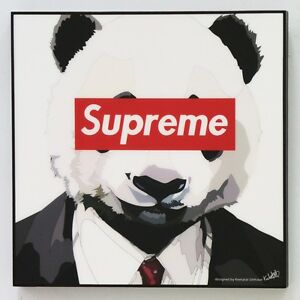
Supreme
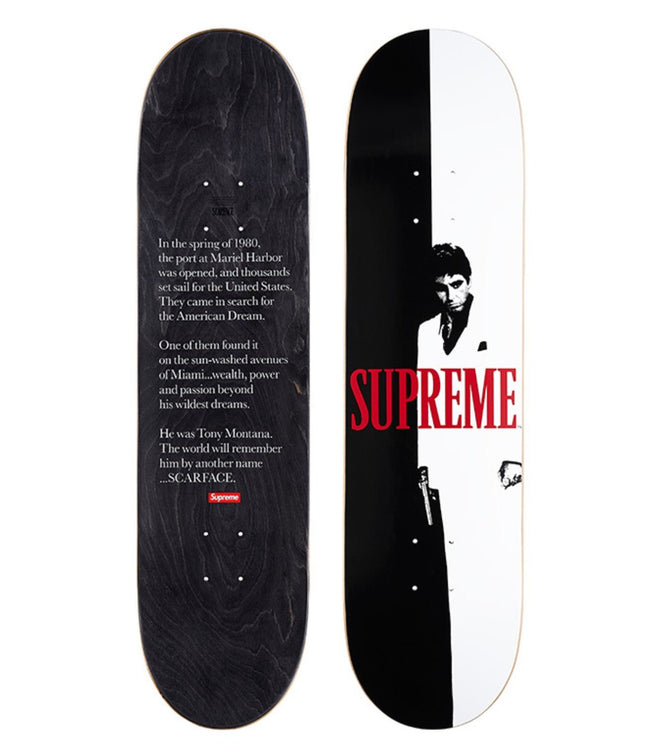
Supreme Scarface Split Skateboard Art Deck by Supreme
Supreme Scarface Split Deck Limited Edition Skateboard deck art by Designer Brand Supreme 2017 Printed Supreme x Scarface Limited Edition Skateboard Deck Depicting Al Pacino as Tony Montana from the Cult Classic Drug Movie Scarface. The Supreme Scarface Split Deck skateboard symbolizes the intersection where street culture, film, and design converge, creating a piece of Street Pop Art and graffiti Artwork that resonates with diverse audiences. This limited edition skateboard deck, released as part of the Fall/Winter 2017 collection by the designer Supreme, features iconic imagery from the cult classic drug movie "Scarface." The deck showcases a striking split design with Al Pacino as Tony Montana, capturing one of the film's most intense moments. Supreme, a brand deeply ingrained in the fabric of streetwear, has consistently demonstrated a knack for blending popular culture with its distinctive style. The collaboration with "Scarface" cements this approach, offering not just a skateboard but a canvas that reflects the gritty and raw narrative of the film. The deck is a homage to the character of Tony Montana, a figure whose pursuit of the American Dream through the darkest avenues of crime has left an indelible mark on cinema and popular culture. The "Shower" deck, in particular, grabs attention with a still from the infamous scene where a drug deal spirals into violence, placing Montana in a life-threatening standoff. This powerful image is complemented by the film's famous tagline on the top of the deck, further embedding the skateboard within the lore of "Scarface." This fusion of art, cinema, and skateboarding culture elevates the piece from a functional item to a collectible artifact within pop and street art. Supreme's decision to feature this graphic during the 2017 Fall/Winter collection was a strategic move that tapped into the nostalgia and aesthetic appeal of the 1980s, when skateboarding and the film "Scarface" rose to prominence. The deck's design captures the essence of that era while remaining relevant to the modern landscape of street art and fashion. As a piece of modern Street Pop Art and graffiti Artwork, the Supreme Scarface Split Deck transcends traditional boundaries, blending functionality with a solid artistic statement. Its creation speaks to a culture that values the defiant spirit of street art and the power of visual storytelling. For enthusiasts and collectors, the deck represents a piece of cultural history, embodying the spirit of rebellion and the relentless pursuit of ambition, themes as relevant today as they were at the time of the film's release.
$750.00
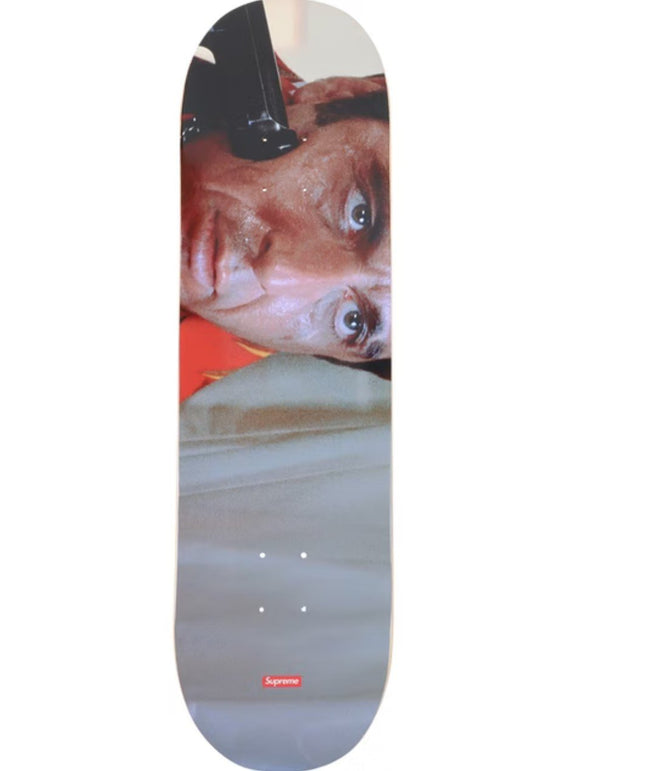
Supreme Scarface Shower Skateboard Art Deck by Supreme
Supreme Scarface Shower Deck Limited Edition Skateboard deck art by Designer Brand Supreme FW17 2017 Supreme x Scarface's iconic imagery was utilized for a full collection of items during the Fall/Winter 2017 collection. Each deck includes the film's famous tagline printed on the top of the deck. This "Shower" deck grabs a still from the infamous scene where a drug deal goes wrong, and Montana is forced into the shower with a gun to his head.
$457.00
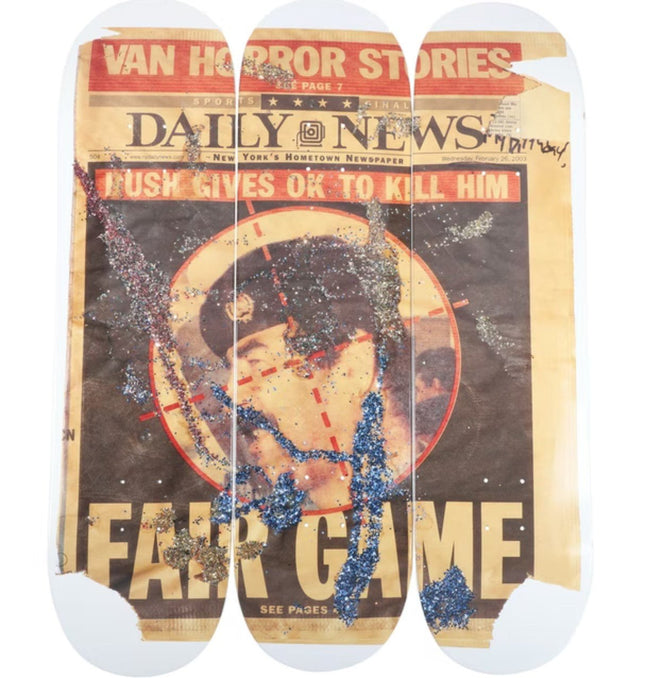
Supreme Dash Snow Set Skateboard Art Deck by Supreme
Supreme Dash Snow Set Decks Limited Edition Skateboard deck art by Designer Brand Supreme FW16 2016- Born and raised on the Upper West Side of New York City, Dash Snow tragically passed away at the age of just 27. Snow was originally known for his photography and as a member of the IRAK graffiti crew in the 1990s. However he became best known for work using newspaper clippings to show his disgust for authoritarian figures, as is the case in this Fall/Winter 2016 collaboration. Sold only as a set, these three skate decks are a piece of art history and classic item in the long line of great Supreme artist collaborations.
$634.00
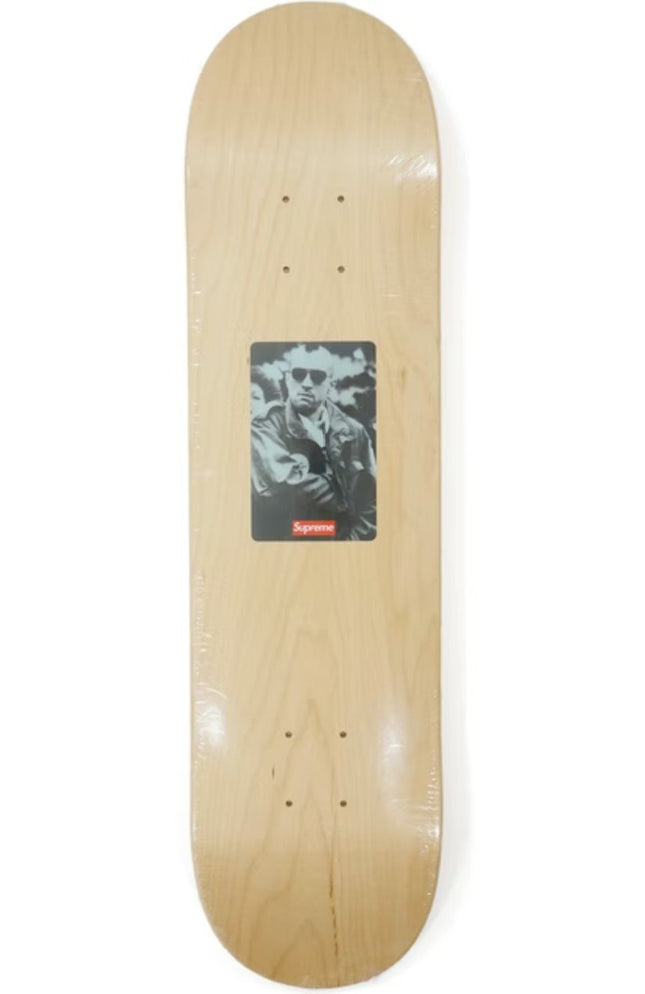
Supreme 20th Anniversary Taxi Driver Natural Skateboard Art Deck by Supreme
Supreme 20th Anniversary Taxi Driver Deck- Natural Fine Art Limited Edition Archival Pigment Print Transfer on Natural Veneer Wood Skateboard Deck by Street Artwork Graffiti Artists at Supreme. 2014 Widely considered one of Robert De Niro's best performances, Taxi Driver was released long before Supreme opened for business in 1994. That didn't stop them from including a stark image of Travis Bickle on one of their first t-shirt's, which eventually made its way onto skateboards in Supreme's 20th Anniversary collection that dropped in April 2014. This natural version features an a clear wood stain on the bottom and includes a Supreme 20th Anniversary seal printed on the top.
$329.00





